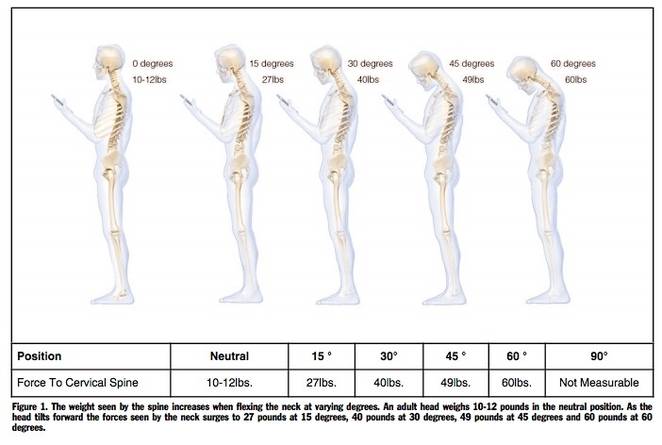
We’ve all seen it. Chances are if you’ve done it, maybe a whole lot. That is, you bend your head forward to text, surf, shop, socialize, whatever, on your smartphone.
Other than the possibility of running into things while you simultaneously walk and stare at your phone, or the possibility of causing a car accident, it doesn’t seem to be too dangerous, right?
Think again. Just the simple act of staring at your smartphone is probably contributing to present or future neck problems.
In fact, Text Neck is a bona fide syndrome. Google it. Here are a couple articles, from WebMD and The Washington Post, that can give you some more details.
When your spine is in a neutral position with your head resting atop your neck, your head weighs 10-12 pounds. Our spines are designed to bear this weight, no problem. For every 10 degrees you flex your neck forward, your head exerts more weight on your neck. At a 60-degree angle, the most extreme angle pictured in the above graphic, your head exerts 60 pounds of force on the cervical spine. The effect of the constant weight on the delicate cervical vertebrae can, over time, reverse the curve or your cervical spine, causing pain and disc dysfunction.
In addition—although the graphic doesn’t depict this—most people hunch their shoulders forward while they’re looking at their phones. This increases the kyphosis (convex curve) in your thoracic spine, increasing the possibility of developing a slumped posture, which will aggravate your neck problems even further. In addition, habitual hunching cuts off your access to the upper lobes of your lungs and can decrease your lung capacity up to 30 percent.
Yoga Has a Remedy (or Two or Three)
Mobilizing your thoracic spine in directions other than flexion (bending forward) can help alleviate text neck. The thoracic spine’s facet joints (the joints that connect the vertebrae with each other) are designed to allow easy flexion, rotation and lateral bending. The thoracic spine is designed for only a minimal degree of extension (backbending).
So I’d suggest beginning your Anti-Text Neck practice with some twists and lateral bends since they are easy ways to mobilize your thoracic spine and therefore, your cervical spine. This will make whatever degree of back bending is possible for you much easier.
Here are some poses to try—two in each category. Of course, there are many more twists, side bends and backbends available to you in the canon of yoga poses, but these can provide a good start:
Twists:
Parvrtta Sukhasana (Rotated Easy Pose)
Jathara Parivartanasana (Revolved Belly Pose)
Lateral Bends:
Talasana – Palm Tree Pose
Parighasana (Gate Latch Pose)
Backbends:
Bhujangasana (Cobra Pose)
Supported Matsyasana (Supported Fish Pose) – my all-time favorite pose for reversing Text Neck
About Shoulder Stand: Shoulder Stand bears the rather ostentatious nickname of “Queen of all Yoga Poses.” While my body loves Shoulder Stand, I recognize that it is not appropriate for everyone, including for people whose shoulders are already in the habit of hunching forward. Shoulder Stand requires your neck to flex forward—same as texting. So Shoulder Stand will likely only exacerbate Text Neck issues.
Also, look at the most extreme head position in the graphic. Note that the neck, even at its maximum angle of flexion is only bent forward to 60 degrees. This is the extreme of your neck’s range of motion in that direction. The only safe way to practice Shoulder Stand is with plenty of blankets (I use four) under your shoulders so that you don’t bear weight on your neck or flex it past its safe range of motion.
Please don’t practice Shoulder Stand with your neck and shoulders on the floor, without added height under your shoulders, even if everyone else in the class is doing it. This is a recipe for huge problems down the road. Find an experienced teacher to show you Shoulder Stand one on one—and ask if he/she uses blankets—so that he/she can evaluate your neck position and guide you into a safe pose, or help you understand whether Shoulder Stand is appropriate for your body.
Why Tilting Your Head Back Isn’t a Solution to Text Neck
Like the thoracic spine, the cervical spine does not backbend. So when we tilt our heads back in an effort to release the cervical spine, it doesn’t actually extend. What we do instead is bend at the juncture between the top of the cervical spine and the base of the skull. Essentially all we do in this position is create compression at the base of the skull.
In order to get the most benefit from your yoga practice in regards to text neck, keep your head in a neutral position relative to your cervical spine. Work on expanding the muscles in the front of the chest and shoulders in order to release tension in the front of the neck.
